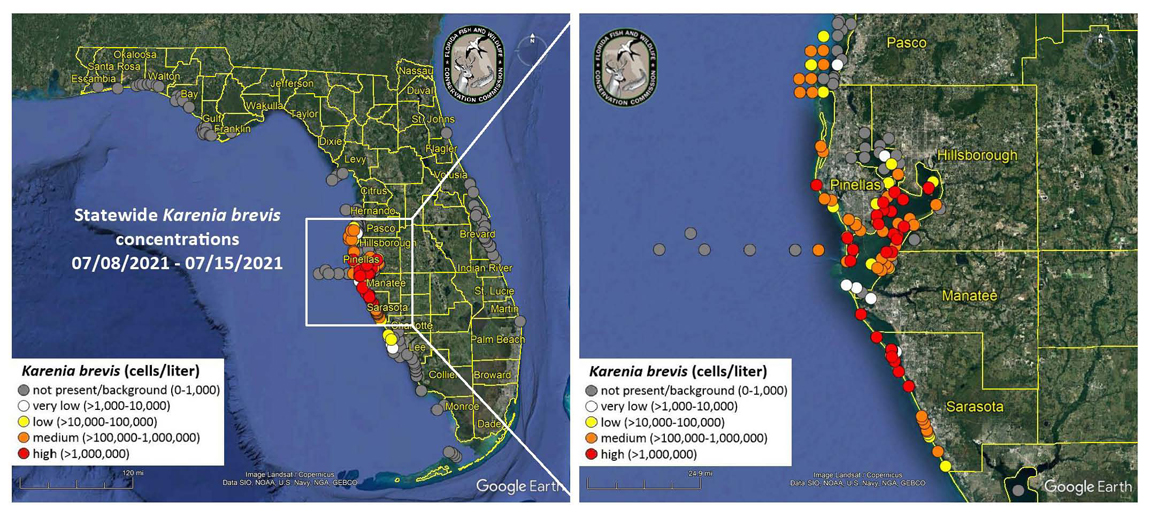TAMPA, Fla. — Red tide continues to kill thousands of fish and other marine life off Florida's Gulf Coast. As of this week, Pinellas County contractors collected more than 2.5 million pounds of red tide-related debris.
Red tide is an annual algal bloom where the overgrowth of karenia brevis in a body of water produces toxins that kill marine life. It can even make it difficult for humans to breathe.
This year’s bloom started off the coast of southern Florida in December 2020, working its way up to St Petersburg by April.
Experts say it’s the worst bloom seen in 50 years. But what does that mean?
“What's unusual about this bloom is the time of year, it's the summer we don't typically have red tide smack in the middle of the summer,” said Leanne Flewelling with the Florida Fish and Wildlife Conservation Commission (FWC). “And in 1971, in a similar, similar time of year with a similar severity and expansive within the bay.”
Flewelling is also the chair of the state’s and Chair of the Harmful Algal Bloom/Red Tide Task Force (HAB), an advisory board created after the 1996 bloom, and brought back together three years ago.

“There's different ways to measure how bad a bloom is, you know, the severity, the high concentrations... the magnitude of the fish kills etc., but also how long does it last, how many counties does it affect,” she explained.
The National Oceanic and Atmospheric Administration says red tide precedes human life, but chemicals from humans can make it worse.
While there’s no yearly quantity of fish kill, an FWC chart shows the persistance of red tide at medium levels or higher in the last 100 years and the trend appears to be growing.
A few blooms in the past several decades lasted multiple years:
- 1994 to 1997 lasted 30 months
- 2002 to 2004 lasted 21 months
- 2004 to 2006 lasted 17 months
- 2017 to 2019 lasted 16 months
So what makes this bloom so bad after only a few months?
“Well, 2018 was rough,” said Jay Gunter, the regional manager for DRC Emergency Services in charge of the crews cleaning up the water in Pinellas County, “The difference, first of all the start of this thing was on the bay and we didn't have any bay issues the last time.”
“We've had red tide six out of the last 10 years, it's made it into the bay, but it doesn't usually get to the upper beaches, and it doesn't usually get to the concentrations that we're seeing now,” Flewelling added.
Flewelling confirmed that the Piney Point phosphate plant spill could have contributed nutrients to the bloom.
"A lot of those nutrients had been taken up or transported out, but once they've been taken up they still can be recycled, like they're still in this system," Flewelling said, "So, it's very possible that that event is contributing to the severity of this bloom."
Runoff of nutrients or chemicals from land into the water also contributes, but what’s really feeding this bloom in the bay is the high levels of salt in the water.
Karenia brevis is a marine species that can't tolerate low salinities.
“We had that long drought over the winter in the spring and so salinities in the bay are much higher than they normally are, or then they should be,” Flewelling said, “1971 was a similarly it was that bloom was preceded by a long drought too so there were unusual salinities in the bay too.”
Comparing this year’s red tide to 1971, there is one thing we need a lot more of to decrease salinilty and control the bloom — that’s rain.
In 1971, there were a number of tropical storms and hurricanes that brought the rain. Tropical Storm Elsa just wasn’t enough to make a difference this year.
The HAB Task Force is also working on a new set of recommendations for the state. Their goal is to complete it by 2021.
Experts say we can’t stop red tide, but they’ve been working on containment methods.
In 2019, Governor Ron Desantis signed the Florida Red Tide Mitigation & Technology Development Initiative.
It’s a partnership between Mote Marine lab and the FWC. The bill provides $3 million from the general revenue fund each year for six years. The program is in its third year.





